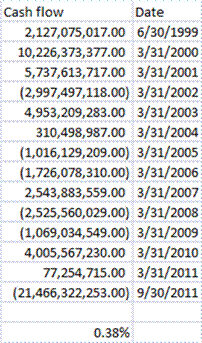I think one of the largest areas for practical investigation in finance is reviewing dollar-weighted versus time weighted returns, especially for vehicles that are traded heavily. I am going to try to analyze one major ETF per month to see what the level of slippage is due to trading.
But if my hypothesis is wrong, I’ll post on it anyway. The last post I did on this was on SPY, the S&P 500 Spider. The slippage was 7%+/year.
Now I have done the calculation for QQQ, the PowerShares QQQ Trust, which mimics the Nasdaq 100. The Nasdaq 100 is more volatile than the S&P 500, so I expected the gap to be worse, but it wasn’t: from the inception in March 1999 to the end of the fiscal year in September of 2011, the dollar weighted return was 0.38%/year versus a time-weighted return that a buy-and-hold investor would get of 0.77%/year. 0.4% of difference isn’t much to talk about. It still indicates a little bad trading.
That said, the net amount of unit creation and liquidation tended to be small. Maybe that is the difference. I have to think more about this, but my advice to anyone using exchange traded products remains the same — read your prospectus carefully, and understand the weaknesses of the vehicle. If creation units don’t have to be something exact, ask what that might imply for your returns.
Anyway, here were the figures from my dollar-weighted return calculation:
I used annual data, and assumed midperiod dates for the cashflows.
The next ETF I plan to analyze is XLF, the Financial Sector Spider. I suspect that will look bad, but who knows?
Full disclosure: short SPY in some hedged accounts.
- English (UK)
- English (India)
- English (Canada)
- English (Australia)
- English (South Africa)
- English (Philippines)
- English (Nigeria)
- Deutsch
- Español (España)
- Español (México)
- Français
- Italiano
- Nederlands
- Português (Portugal)
- Polski
- Português (Brasil)
- Русский
- Türkçe
- العربية
- Ελληνικά
- Svenska
- Suomi
- עברית
- 日本語
- 한국어
- 简体中文
- 繁體中文
- Bahasa Indonesia
- Bahasa Melayu
- ไทย
- Tiếng Việt
- हिंदी
We Eat Dollar Weighted Returns (Part IV)
Published 05/06/2012, 01:03 AM
Updated 07/09/2023, 06:31 AM
We Eat Dollar Weighted Returns (Part IV)
Latest comments
Loading next article…
Install Our App
Risk Disclosure: Trading in financial instruments and/or cryptocurrencies involves high risks including the risk of losing some, or all, of your investment amount, and may not be suitable for all investors. Prices of cryptocurrencies are extremely volatile and may be affected by external factors such as financial, regulatory or political events. Trading on margin increases the financial risks.
Before deciding to trade in financial instrument or cryptocurrencies you should be fully informed of the risks and costs associated with trading the financial markets, carefully consider your investment objectives, level of experience, and risk appetite, and seek professional advice where needed.
Fusion Media would like to remind you that the data contained in this website is not necessarily real-time nor accurate. The data and prices on the website are not necessarily provided by any market or exchange, but may be provided by market makers, and so prices may not be accurate and may differ from the actual price at any given market, meaning prices are indicative and not appropriate for trading purposes. Fusion Media and any provider of the data contained in this website will not accept liability for any loss or damage as a result of your trading, or your reliance on the information contained within this website.
It is prohibited to use, store, reproduce, display, modify, transmit or distribute the data contained in this website without the explicit prior written permission of Fusion Media and/or the data provider. All intellectual property rights are reserved by the providers and/or the exchange providing the data contained in this website.
Fusion Media may be compensated by the advertisers that appear on the website, based on your interaction with the advertisements or advertisers.
Before deciding to trade in financial instrument or cryptocurrencies you should be fully informed of the risks and costs associated with trading the financial markets, carefully consider your investment objectives, level of experience, and risk appetite, and seek professional advice where needed.
Fusion Media would like to remind you that the data contained in this website is not necessarily real-time nor accurate. The data and prices on the website are not necessarily provided by any market or exchange, but may be provided by market makers, and so prices may not be accurate and may differ from the actual price at any given market, meaning prices are indicative and not appropriate for trading purposes. Fusion Media and any provider of the data contained in this website will not accept liability for any loss or damage as a result of your trading, or your reliance on the information contained within this website.
It is prohibited to use, store, reproduce, display, modify, transmit or distribute the data contained in this website without the explicit prior written permission of Fusion Media and/or the data provider. All intellectual property rights are reserved by the providers and/or the exchange providing the data contained in this website.
Fusion Media may be compensated by the advertisers that appear on the website, based on your interaction with the advertisements or advertisers.
© 2007-2025 - Fusion Media Limited. All Rights Reserved.
